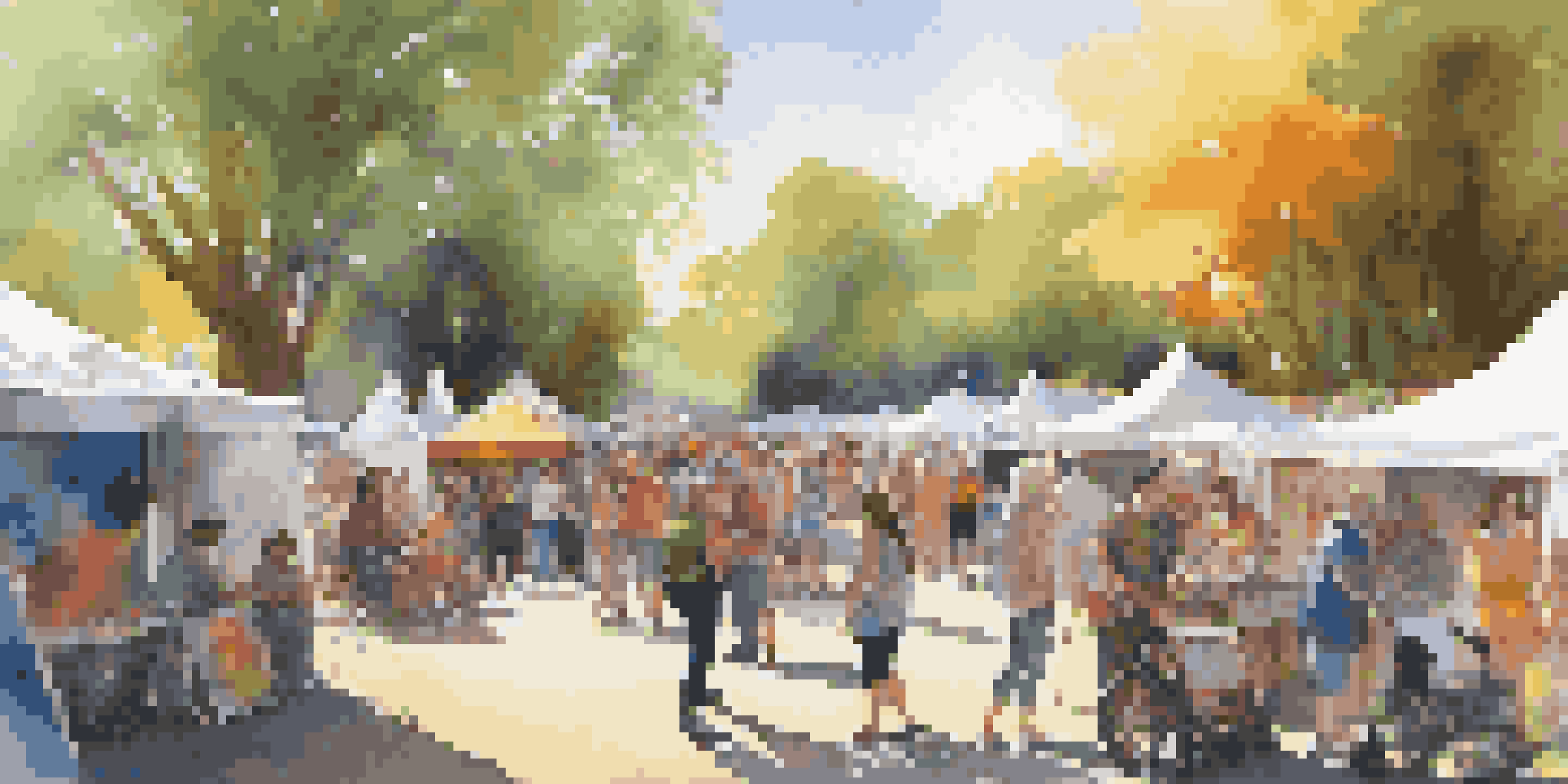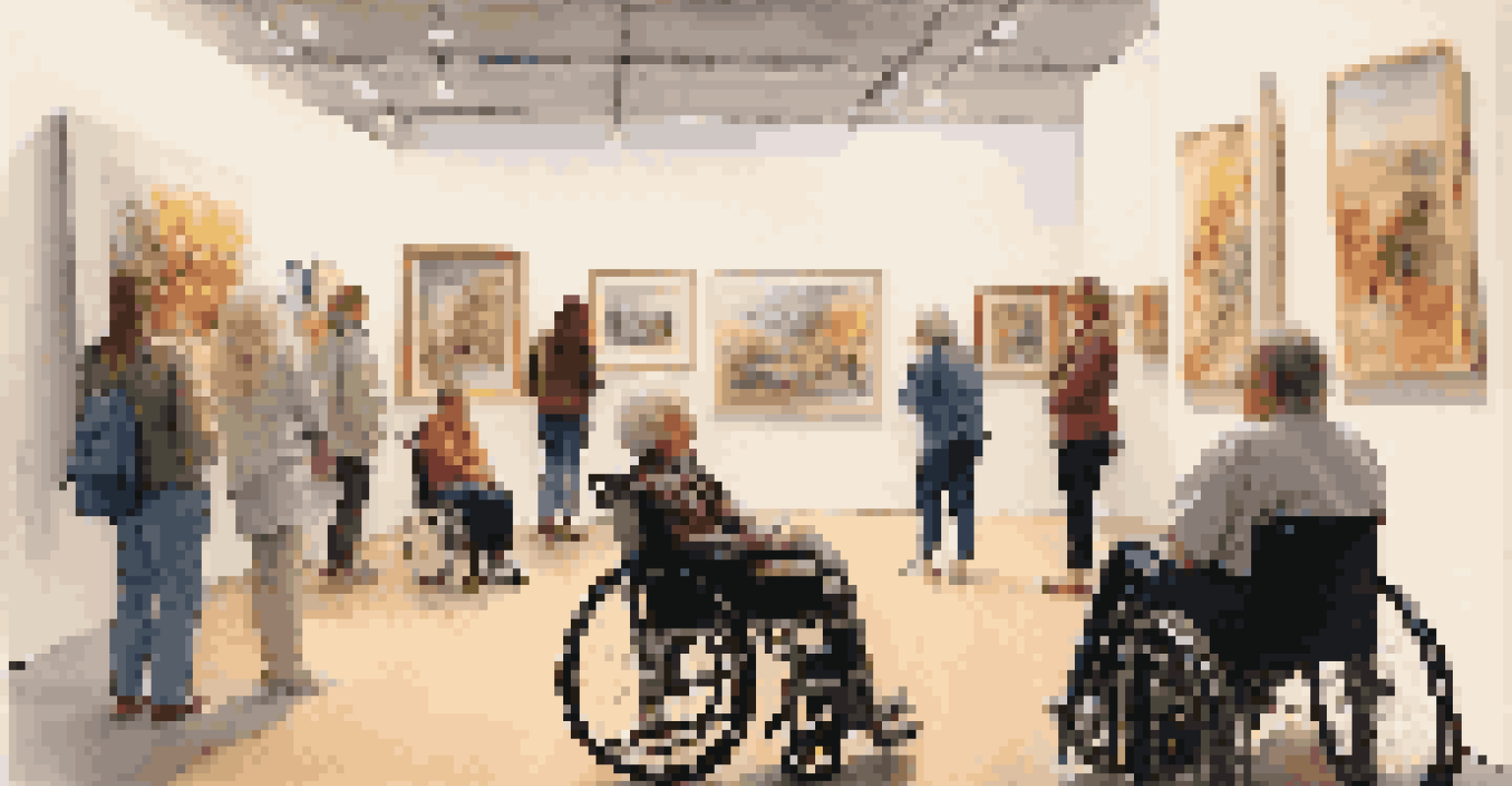The Impact of Art Festivals on Disability Representation

Understanding Disability Representation in Art Festivals
Disability representation in art is crucial for fostering inclusivity. Art festivals often serve as platforms where diverse voices can be heard, including those of disabled artists. By showcasing their work, these festivals challenge stereotypes and promote a more nuanced understanding of disability.
Art is a way of survival, and I think it’s important to have diverse voices in that conversation.
When disabled artists participate in festivals, they not only highlight their unique perspectives but also encourage dialogue about accessibility and representation in the arts. This visibility can inspire both creators and audiences to engage with disability in a more informed way.
Ultimately, the presence of disabled artists in these festivals enriches the cultural landscape, making it more vibrant and reflective of society as a whole. It creates an environment where everyone can find something relatable, fostering empathy and connection among all attendees.
The Role of Art Festivals in Promoting Accessibility
Art festivals often take steps to ensure accessibility, which is vital for disabled artists and attendees. This includes physical access to venues, as well as accommodations such as sign language interpreters and sensory-friendly spaces. By prioritizing accessibility, festivals can create an inclusive environment that welcomes everyone.

Moreover, when art festivals lead the charge in accessibility initiatives, they set a precedent for other cultural events. This ripple effect encourages more organizations to adopt similar practices, leading to a broader cultural shift towards inclusivity.
Art Festivals Foster Inclusion
Art festivals serve as vital platforms for showcasing the work of disabled artists, challenging stereotypes and promoting understanding.
Accessible art festivals also empower disabled individuals to engage fully with the arts. It allows them to experience art not just as spectators but as active participants, whether they are creating, exhibiting, or simply enjoying the works of others.
Highlighting Unique Artistic Perspectives from Disabled Creators
Disabled artists often bring unique experiences and viewpoints to their work, enriching the artistic conversation. These perspectives can challenge conventional narratives and invite audiences to rethink their understanding of disability. Art festivals provide a platform for these voices, ensuring they are not sidelined.
Inclusion is not a matter of political correctness. It is the key to growth.
For example, a disabled artist might use their medium to explore themes of identity, resilience, or society's perception of disability. This not only validates their experiences but also educates audiences, fostering a deeper understanding of the challenges and triumphs faced by disabled individuals.
The diversity of thought and expression that disabled artists bring to festivals can lead to transformative experiences for viewers. By engaging with this art, audiences can gain insight into the lives of disabled individuals, promoting empathy and connection.
Community Building Through Art Festivals
Art festivals are more than just showcases; they are community-building events. When disabled artists and audiences come together, they create a shared space that promotes understanding and collaboration. This sense of community can be particularly empowering for disabled individuals, who may often feel marginalized.
These gatherings allow for networking and relationship-building among artists, curators, and audiences. It fosters an environment where disabled artists can find allies and advocates, amplifying their voices within the broader art community.
Accessibility Empowers Participation
Prioritizing accessibility at art festivals allows disabled individuals to engage fully as creators and audiences, enriching the cultural experience.
Additionally, community-building through art festivals can lead to long-lasting partnerships and projects that continue beyond the event. This ongoing collaboration can further enhance representation and visibility for disabled artists in the future.
Influence on Future Art Trends and Movements
The representation of disabled artists at festivals can significantly influence future art trends and movements. As audiences engage with diverse artistic expressions, they may begin to demand more inclusivity in the art world. This shift can encourage curators and galleries to prioritize works by disabled artists.
Moreover, when disabled artists take center stage, they challenge the status quo and inspire new artistic movements that prioritize authenticity and representation. This can lead to a broader acceptance of varied artistic styles and themes that reflect the complexity of human experiences.
Ultimately, the impact of art festivals on trends and movements can create a more inclusive art scene that values and respects the contributions of disabled artists. This evolution not only benefits the artists themselves but enriches the entire cultural landscape.
Challenges Faced by Disabled Artists in Art Festivals
Despite the positive strides made by art festivals, disabled artists still face numerous challenges. Access to funding, resources, and opportunities can be limited, making it difficult for them to showcase their work. This can hinder their ability to participate fully in festivals and gain visibility.
Additionally, systemic barriers within the art world can perpetuate exclusion. From inadequate representation in governance structures to biases in curation, these obstacles can make it challenging for disabled artists to break through and have their work recognized.
Community Strengthens Artistic Voices
Art festivals facilitate community building, enabling disabled artists to connect, collaborate, and amplify their visibility within the art world.
Addressing these challenges requires concerted efforts from festival organizers, curators, and the broader art community. By actively seeking to dismantle these barriers, they can create a more equitable environment for disabled artists to thrive.
The Future of Disability Representation in Art Festivals
The future of disability representation in art festivals looks promising, with an increasing awareness of the importance of inclusivity. More organizers are recognizing the need to feature disabled artists and create accessible environments that encourage participation. This trend is a positive step towards a more equitable art world.
As conversations around disability and representation continue to evolve, it’s likely that art festivals will adapt and innovate in ways that further enhance visibility for disabled creators. This could involve new formats, such as virtual events, that expand reach and accessibility.

Ultimately, the continued commitment to disability representation in art festivals will lead to a richer, more diverse cultural landscape. By embracing these changes, the art world can ensure that all voices are heard and celebrated.